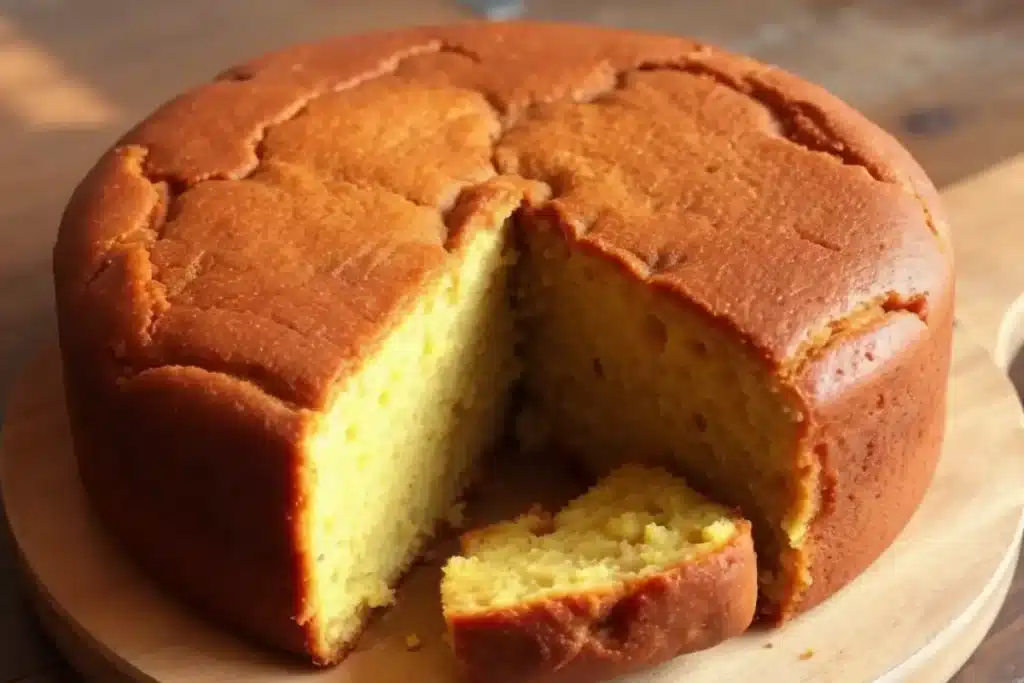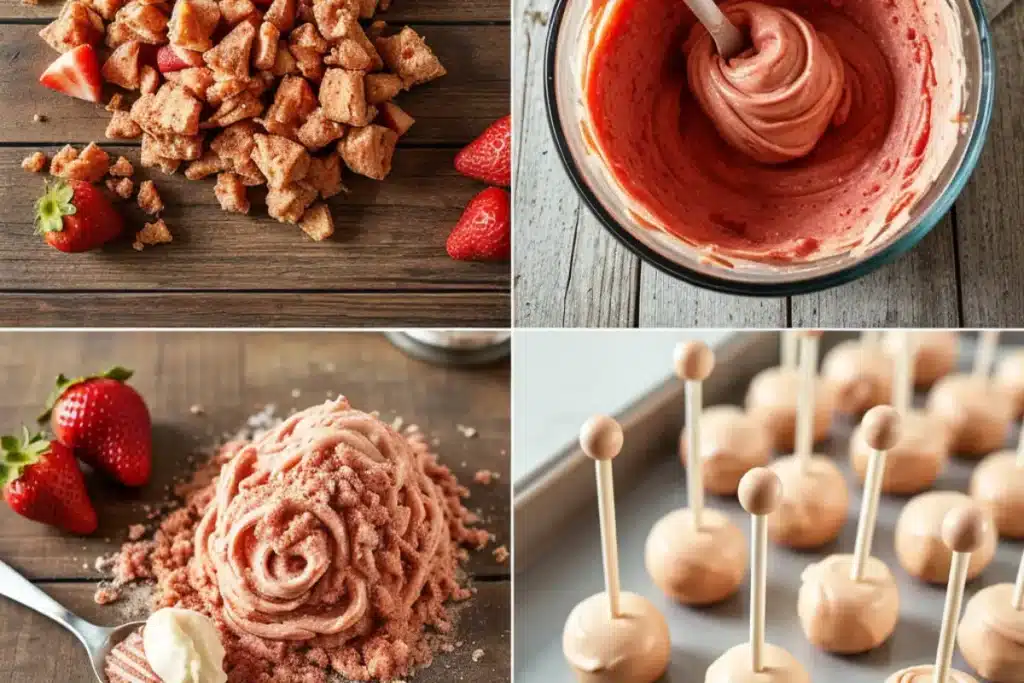Why Is My Strawberry Cake so Dense? Baking a strawberry cake is always a delightful experience, but nothing is more frustrating than discovering it’s dense and heavy instead of light and fluffy. Dense cakes are a common problem, especially with fruit-based cakes like strawberry. Understanding the science behind cake structure and avoiding common mistakes will help you achieve the perfect airy strawberry cake every time.
This comprehensive guide covers the causes of dense cakes and provides practical tips to prevent and fix them. From measuring ingredients accurately to incorporating strawberries the right way, you’ll learn the best techniques for baking a soft and flavorful strawberry cake. 🍰
Table of Contents
The Science Behind Why Is My Strawberry Cake So Dense

The texture of a cake depends on the balance of its ingredients and their interaction during baking. A dense cake happens when this balance is off. Here’s what can go wrong and how to fix it:
1. Incorrect Ingredient Measurements ⚖️
Precision is key in baking. Even small errors in measuring flour, sugar, or leavening agents can result in a dense cake.
- Too Much Flour – Over-measuring flour results in a dry, dense cake since flour absorbs moisture. Always use the spoon and level method.
- Too Much Sugar – Excess sugar can cause the cake’s structure to collapse, making it dense.
- Improper Leavening Agents – Incorrect amounts of baking powder or baking soda prevent the cake from rising properly. Use a kitchen scale for accuracy.
2. Overmixing the Batter 🌀
- Tough Texture – Overmixing activates too much gluten, leading to a tough cake.
- Loss of Air Incorporation – Overmixing eliminates air bubbles, making the cake heavy.
Fix: Mix the batter until just combined. Use a low speed and finish mixing by hand if needed.
3. Baking at the Wrong Temperature 🌡️
- Low Temperature – The cake won’t rise properly, leading to a dense texture.
- High Temperature – The cake rises too fast and collapses, creating a dense center.
Fix: Always preheat your oven and use an oven thermometer to verify the correct temperature.
For more baking tips, check out our Strawberry Earthquake Cake guide, which focuses on texture and consistency.
Common Causes of Why Is My Strawberry Cake So Dense 🍓
1. Too Much Moisture from Strawberries 💦
Strawberries are naturally high in water content, which can make the cake batter too wet.
Fix:
- Macerate Fresh Strawberries – Toss with sugar and let sit for 15 minutes to release excess liquid.
- Thaw and Drain Frozen Strawberries – Ensure all excess liquid is removed before adding them to the batter.
2. Adding Too Much Puree 🏺
Strawberry puree enhances flavor, but excess moisture can lead to a dense cake.
Fix:
- Stick to the recommended amount of puree in your recipe.
- Use a strawberry reduction to intensify flavor without excess liquid.
3. Incorrect Measurement of Ingredients 📏
- Overmeasuring Flour or Sugar – Too much flour = dry cake; too much sugar = weak structure.
- Expired Leavening Agents – Baking powder and baking soda lose potency over time.
Fix:
- Always measure carefully and use fresh baking powder/baking soda.
Looking for more inspiration? Try our Strawberry Crunch Poke Cake for a fun and crunchy twist! 🍓🎂
Fixing a Dense Strawberry Cake 🍰
If your cake has already turned out dense, don’t worry! Here are some ways to salvage it:
1. Syrup or Soak Method 🍯
- Simple Syrup – Brush a mixture of equal parts sugar and water onto cake layers to restore moisture.
- Flavored Syrup – Add strawberry puree or extract for extra flavor.
2. Layering with Whipped Cream or Mousse 🥄
- Whipped Cream – A light, airy filling balances out a dense cake.
- Mousse – Strawberry or chocolate mousse adds a creamy contrast.

3. Repurposing Dense Cake 🎂
- Cake Pops – Crumble dense cake and mix with frosting to make bite-sized treats.
- Trifle – Layer dense cake with custard, whipped cream, and fresh strawberries.
Pro Tips to Prevent Dense Strawberry Cakes in the Future 🏆
1. Use Room Temperature Ingredients 🌡️
- Cold ingredients don’t mix well, leading to a dense batter. Ensure your butter, eggs, and milk are at room temperature before baking.
2. Be Mindful of the Mixing Process 🌀
- Use Low Speed – Mix ingredients slowly to avoid overworking the batter.
- Alternate Wet & Dry Ingredients – Helps maintain an even texture.
3. Choose the Right Flour 🌾
- Cake Flour – Lower protein content for a light, tender crumb.
- All-Purpose Flour – Can work but may result in a slightly denser cake. Substitute cake flour by replacing 2 tbsp of flour with cornstarch per cup.
4. Test & Replace Leavening Agents 🧪
- Old baking powder or soda? Test by adding to water or vinegar—if it fizzes, it’s still active!
If you're looking for another way to enjoy fresh strawberries in desserts, try this Fresh Strawberry Cake for a simple yet flavorful treat! 🍓🍰
Baking the perfect strawberry cake requires attention to detail and understanding the delicate balance of ingredients and techniques. By measuring accurately, avoiding overmixing, and handling strawberries properly, you can ensure a soft, airy texture every time. 🍓
With these strategies, you’ll no longer have to worry about dense cakes—just light, fluffy slices bursting with fresh strawberry flavor. Happy baking! 🧁
Frequently Asked Questions (FAQs) ❓
Why is my strawberry cake dense and not fluffy?
- Overmixing, incorrect ingredient measurements, or baking at the wrong temperature are the most common reasons.
Can adding too much strawberry puree make the cake dense?
- Yes, excess moisture can weigh down the batter. Stick to the recommended amount or use a strawberry reduction.
What if I don’t have cake flour?
- Substitute all-purpose flour by removing 2 tbsp per cup and replacing it with cornstarch.


4 thoughts on “Why Is Your Strawberry Cake Dense?”